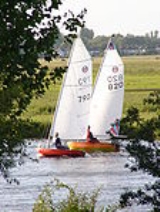
British Moth
Encyclopedia
British moth is the name of an 11 foot (3.3528 meter) sailing dinghy
designed in 1932 by Sydney Cheverton.
The first boats built were sailed on the Brent Reservoir
in North London
. British Moths were the first class to use this famous stretch of water for dinghy racing, and for a time it was known as the "Brent One Design". The British Moth National Championship trophy is still the Brent Cup.
Unfortunately, after World War II
, sailing
was not resumed on the Brent Reservoir and the boats became somewhat scattered. However, the British Moth continued to be sailed at other clubs and now has a relatively small but dedicated following.
In 2004 the British Moth Boat Association funded the development of a new hull mould designed by Ian Howlett. This has seen renewed activity within club fleets and a number of river clubs taking up the class.
Dinghy sailing
Dinghy sailing is the activity of sailing small boats by using five essential controls:* the sails* the foils ....
designed in 1932 by Sydney Cheverton.
The first boats built were sailed on the Brent Reservoir
Brent Reservoir
The Brent Reservoir is a reservoir which straddles the boundary between the London boroughs of Brent and Barnet and is owned by British Waterways...
in North London
North London
North London is the northern part of London, England. It is an imprecise description and the area it covers is defined differently for a range of purposes. Common to these definitions is that it includes districts located north of the River Thames and is used in comparison with South...
. British Moths were the first class to use this famous stretch of water for dinghy racing, and for a time it was known as the "Brent One Design". The British Moth National Championship trophy is still the Brent Cup.
Unfortunately, after World War II
World War II
World War II, or the Second World War , was a global conflict lasting from 1939 to 1945, involving most of the world's nations—including all of the great powers—eventually forming two opposing military alliances: the Allies and the Axis...
, sailing
Sailing
Sailing is the propulsion of a vehicle and the control of its movement with large foils called sails. By changing the rigging, rudder, and sometimes the keel or centre board, a sailor manages the force of the wind on the sails in order to move the boat relative to its surrounding medium and...
was not resumed on the Brent Reservoir and the boats became somewhat scattered. However, the British Moth continued to be sailed at other clubs and now has a relatively small but dedicated following.
In 2004 the British Moth Boat Association funded the development of a new hull mould designed by Ian Howlett. This has seen renewed activity within club fleets and a number of river clubs taking up the class.

